Polyxena Collection
Polyxena, a tragic figure from the Trojan War, has captivated artists and storytellers throughout history
All Professionally Made to Order for Quick Shipping
Polyxena, a tragic figure from the Trojan War, has captivated artists and storytellers throughout history. In one of the most poignant moments of this epic conflict, Polyxena is sacrificed to appease the gods and ensure victory for the Greeks. Giovanni David's masterpiece "The Sacrifice of Polyxena" immortalizes this heart-wrenching event in 1776. The painting depicts her final moments as she meets her fate with bravery and grace. Another rendition by Charles le Brun in 1647 captures the intensity of this sacrifice on canvas. But who was Polyxena? She was a princess of Troy, daughter of King Priam and Queen Hecuba. Her beauty was renowned, attracting suitors from far and wide. However, it was Achilles who won her heart before his untimely death during the war. In Greek mythology, Apollo transformed himself into an eagle to abduct Polyxena after Achilles' demise. This story inspired various works like Professor Pio Fedi's engraving titled "The Rape of Polyxena, " displayed at Florence's Loggia. Nature also pays homage to this tragic tale through its creations. The Southern festoon butterfly (also known as Spanish festoon or false Apollo) bears resemblance to Apollo butterfly (Parnassius apollo). These delicate creatures symbolize both beauty and sacrifice - just like Polyxena herself. Engravings such as "The Sacrifice of Polyxena" further perpetuate her legend across time. One such engraving can be found in "Bacchanals and Histories, " published in 1744. Polyxena's story continues to resonate today because it explores themes like love, loss, sacrifice, and tragedy that are universal human experiences. Artists have sought to capture these emotions through their artistry over centuries – reminding us that even amidst destruction and war there is room for compassion and empathy towards those who suffer.

















